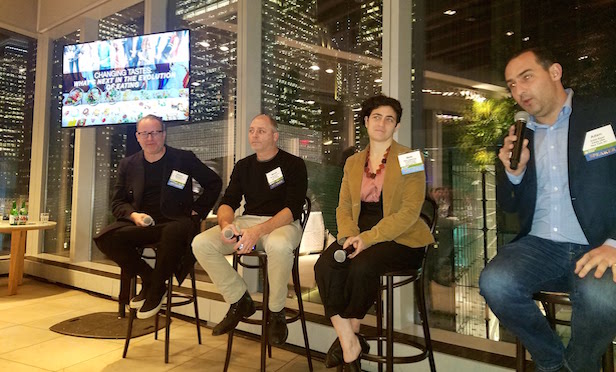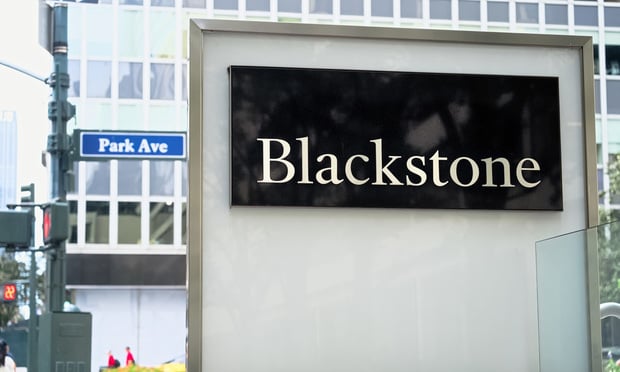
NEW YORK CITY—In emphasizing that real estate is not always about dollars per square foot, Marcel Van Ooyen, president and CEO of GrowNYC, said farmers at the Union Square Greenmarket are charged little or nothing to sell their produce. But before the market had moved in, the area was called “Needle Park” due to all the drug use. The scene also included a biker bar across the street and frequent public fighting, according to Van Ooyen.
“We built that neighborhood up” he said, noting the Danny Meyer's restaurant and Whole Foods later followed the greenmarket to Union Square. “If you're in real estate, you have to realize a fabulous asset doesn't mean just how much money it brings. It means how much life you can bring to that location.”
On Tuesday night, at the downtown Eataly, located at 4 World Trade Center, Van Ooyen, joined Adam Saper, managing partner, Eataly, USA, Beth Lieberman, director of operations, the Market Line at Essex Crossing, and Steven Cornwell, chief marketing officer, the Howard Hughes Corporation, on a panel organized by the Urban Land Institute New York. Addressing the influence of food trends on real estate, the speakers unanimously agreed that today's market requires a new way of developers working with tenants.
Saper said the downturn in the real estate market helped the company open Eataly, USA on 23rd Street in 2010. At one time, food tenants were not the premier choice for New York real estate leases.
Real estate developers once controlled access to consumer retail. They had the space and leased it out to retailers. But pointing to the internet, Amazon and alternative ways of purchasing items, Saper underscored how experiences, such as those offered by bringing people together with food, make sense for brick-and-mortar retail.
“Everything that's new is old,” said Van Ooyen. “The concepts of communal tables and open kitchens have been going on since the beginning of time.” In the city's history at the founding of New Amsterdam, farmers brought their food to market, and people bought it. He emphasized how food has always been something that brings people together.
The food industry is a key component in experiential retail, as people cannot share food over the Internet.
It turns out Eataly is also a great place for first dates, according to Saper. “You'll never be bored. There's always something to talk about. It's a great meeting place,” he said.
The Howard Hughes Corporation is the developer behind the South Street Seaport. Cornwell pointed out this location's main demographic comprises 25 to 35-year-olds. They are looking for local experiences that are not mass produced, with food being a major part of the experience economy. He noted this age group recoils from chain restaurants. They want something unique, consistent with the locally sourced, farm-to-table experience.
“Developers cannot just be passive rent collectors,” said Cornwell. “They must actively create value.” He added there must be a cultural fit with the tenant and the landlord having a shared vision for the enterprise. The role of the strategic developer is evolving into operator.
Lieberman agreed, referring to herself as a “professional mom” of retail tenants. She noted it is not just about signing the lease but also maintenance and operations. To honor the Market Line's mission, she seeks the smaller, entrepreneurial vendors, which often have less experience and need more hand-holding.
Lieberman requires that tenants fulfill their responsibilities including arriving and closing at certain times. She will get into the specifics of telling them how often they need to clean their kitchen exhaust systems. If tenants do not do something right, Lieberman will let them know, as they share goals of seeing the businesses thrive.
Similarly, there are strict rules at the farmers' market. Vendors must grow the food they sell. They must be honest when claiming produce is organic. Offenders who violate the rules will be prohibited from selling at the square. GrowNYC also supports the farmers, providing business guidance in matters such as how to set up a limited liability corporation or improve marketing and sales tactics.
Felix Ciampa, executive director of the Urban Land Institute, welcomed and thanked the speakers and guests. He explained the mission of the institute, a non-profit, is to provide leadership in the responsible use of land and in creating and sustaining thriving communities.

“We built that neighborhood up” he said, noting the Danny Meyer's restaurant and Whole Foods later followed the greenmarket to Union Square. “If you're in real estate, you have to realize a fabulous asset doesn't mean just how much money it brings. It means how much life you can bring to that location.”
On Tuesday night, at the downtown Eataly, located at 4 World Trade Center, Van Ooyen, joined Adam Saper, managing partner, Eataly, USA, Beth Lieberman, director of operations, the Market Line at Essex Crossing, and Steven Cornwell, chief marketing officer, the Howard Hughes Corporation, on a panel organized by the Urban Land Institute
Saper said the downturn in the real estate market helped the company open Eataly, USA on 23rd Street in 2010. At one time, food tenants were not the premier choice for
Real estate developers once controlled access to consumer retail. They had the space and leased it out to retailers. But pointing to the internet, Amazon and alternative ways of purchasing items, Saper underscored how experiences, such as those offered by bringing people together with food, make sense for brick-and-mortar retail.
“Everything that's new is old,” said Van Ooyen. “The concepts of communal tables and open kitchens have been going on since the beginning of time.” In the city's history at the founding of New Amsterdam, farmers brought their food to market, and people bought it. He emphasized how food has always been something that brings people together.
The food industry is a key component in experiential retail, as people cannot share food over the Internet.
It turns out Eataly is also a great place for first dates, according to Saper. “You'll never be bored. There's always something to talk about. It's a great meeting place,” he said.
The Howard Hughes Corporation is the developer behind the South Street Seaport. Cornwell pointed out this location's main demographic comprises 25 to 35-year-olds. They are looking for local experiences that are not mass produced, with food being a major part of the experience economy. He noted this age group recoils from chain restaurants. They want something unique, consistent with the locally sourced, farm-to-table experience.
“Developers cannot just be passive rent collectors,” said Cornwell. “They must actively create value.” He added there must be a cultural fit with the tenant and the landlord having a shared vision for the enterprise. The role of the strategic developer is evolving into operator.
Lieberman agreed, referring to herself as a “professional mom” of retail tenants. She noted it is not just about signing the lease but also maintenance and operations. To honor the Market Line's mission, she seeks the smaller, entrepreneurial vendors, which often have less experience and need more hand-holding.
Lieberman requires that tenants fulfill their responsibilities including arriving and closing at certain times. She will get into the specifics of telling them how often they need to clean their kitchen exhaust systems. If tenants do not do something right, Lieberman will let them know, as they share goals of seeing the businesses thrive.
Similarly, there are strict rules at the farmers' market. Vendors must grow the food they sell. They must be honest when claiming produce is organic. Offenders who violate the rules will be prohibited from selling at the square. GrowNYC also supports the farmers, providing business guidance in matters such as how to set up a limited liability corporation or improve marketing and sales tactics.
Felix Ciampa, executive director of the Urban Land Institute, welcomed and thanked the speakers and guests. He explained the mission of the institute, a non-profit, is to provide leadership in the responsible use of land and in creating and sustaining thriving communities.
Want to continue reading?
Become a Free ALM Digital Reader.
Once you are an ALM Digital Member, you’ll receive:
- Breaking commercial real estate news and analysis, on-site and via our newsletters and custom alerts
- Educational webcasts, white papers, and ebooks from industry thought leaders
- Critical coverage of the property casualty insurance and financial advisory markets on our other ALM sites, PropertyCasualty360 and ThinkAdvisor
Already have an account? Sign In Now
*May exclude premium content© 2025 ALM Global, LLC, All Rights Reserved. Request academic re-use from www.copyright.com. All other uses, submit a request to [email protected]. For more information visit Asset & Logo Licensing.








